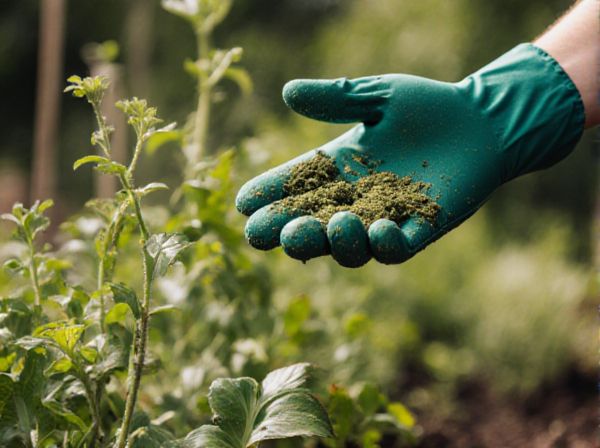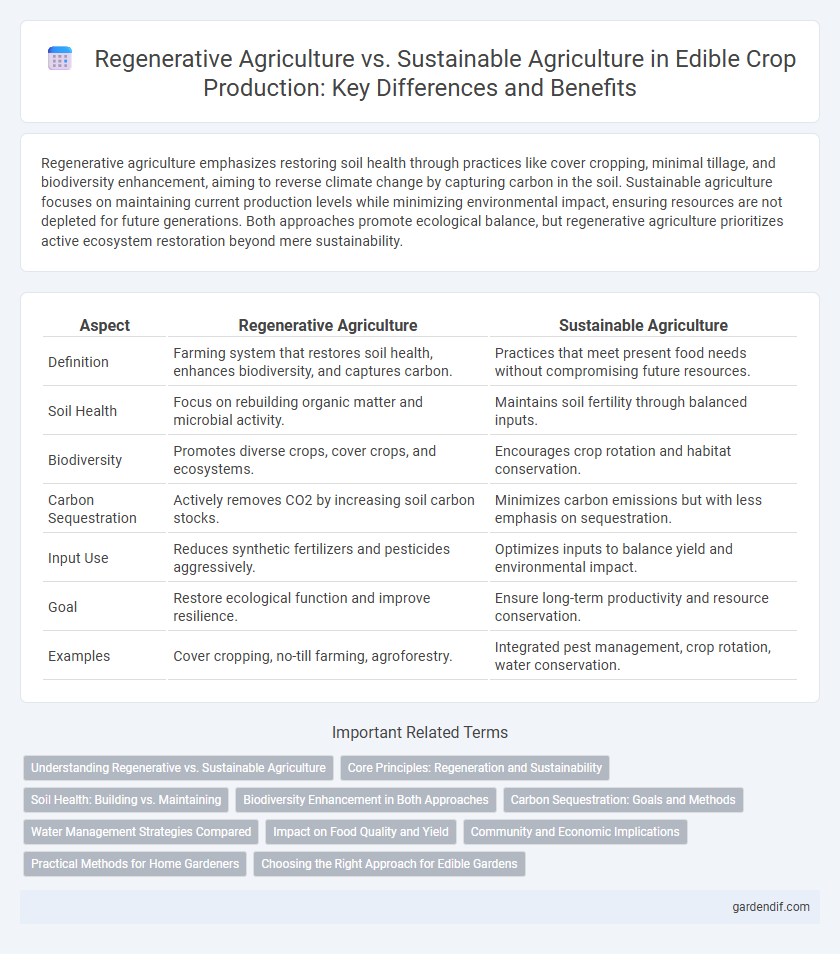
Regenerative agriculture vs Sustainable agriculture Illustration
Regenerative agriculture emphasizes restoring soil health through practices like cover cropping, minimal tillage, and biodiversity enhancement, aiming to reverse climate change by capturing carbon in the soil. Sustainable agriculture focuses on maintaining current production levels while minimizing environmental impact, ensuring resources are not depleted for future generations. Both approaches promote ecological balance, but regenerative agriculture prioritizes active ecosystem restoration beyond mere sustainability.
Table of Comparison
| Aspect | Regenerative Agriculture | Sustainable Agriculture |
|---|---|---|
| Definition | Farming system that restores soil health, enhances biodiversity, and captures carbon. | Practices that meet present food needs without compromising future resources. |
| Soil Health | Focus on rebuilding organic matter and microbial activity. | Maintains soil fertility through balanced inputs. |
| Biodiversity | Promotes diverse crops, cover crops, and ecosystems. | Encourages crop rotation and habitat conservation. |
| Carbon Sequestration | Actively removes CO2 by increasing soil carbon stocks. | Minimizes carbon emissions but with less emphasis on sequestration. |
| Input Use | Reduces synthetic fertilizers and pesticides aggressively. | Optimizes inputs to balance yield and environmental impact. |
| Goal | Restore ecological function and improve resilience. | Ensure long-term productivity and resource conservation. |
| Examples | Cover cropping, no-till farming, agroforestry. | Integrated pest management, crop rotation, water conservation. |
Understanding Regenerative vs. Sustainable Agriculture
Regenerative agriculture focuses on restoring soil health, increasing biodiversity, and enhancing ecosystem services by using practices like cover cropping, no-till farming, and rotational grazing. Sustainable agriculture aims to maintain productivity and profitability over time while minimizing environmental impact through efficient resource use and conservation methods. Understanding the distinction helps in adopting approaches that not only sustain but also improve agricultural ecosystems for future food security.
Core Principles: Regeneration and Sustainability
Regenerative agriculture prioritizes restoring soil health, increasing biodiversity, and enhancing ecosystem resilience through practices like cover cropping, no-till farming, and agroforestry. Sustainable agriculture aims to maintain productivity and minimize environmental impact by efficiently using resources, reducing pollution, and conserving water and soil for long-term viability. Both approaches seek to balance agricultural productivity with environmental stewardship, yet regeneration emphasizes active ecosystem restoration while sustainability focuses on maintaining current resource levels.
Soil Health: Building vs. Maintaining
Regenerative agriculture focuses on building soil health through practices like cover cropping, crop rotation, and reduced tillage to enhance organic matter and microbial diversity. Sustainable agriculture aims to maintain existing soil health by preventing degradation and minimizing harmful inputs while promoting long-term productivity. The key difference lies in regenerative methods actively restoring soil vitality, whereas sustainable approaches emphasize conservation and stability.
Biodiversity Enhancement in Both Approaches
Regenerative agriculture prioritizes biodiversity enhancement by restoring natural ecosystems through crop rotation, cover cropping, and reduced chemical inputs, which improve soil health and habitat variety. Sustainable agriculture focuses on maintaining biodiversity by balancing productive farming with conservation practices, such as integrated pest management and responsible land use. Both approaches contribute to ecosystem resilience but differ in intensity and long-term soil regeneration goals.
Carbon Sequestration: Goals and Methods
Regenerative agriculture prioritizes carbon sequestration by enhancing soil organic matter through practices like cover cropping, reduced tillage, and diverse crop rotations, aiming to restore ecosystem health and increase soil carbon stocks. Sustainable agriculture focuses on maintaining current productivity with moderate carbon management techniques, such as integrated pest management and efficient resource use, to minimize carbon emissions without necessarily increasing soil carbon. Both approaches target climate mitigation but differ in intensity and methods of carbon sequestration to achieve environmental goals.
Water Management Strategies Compared
Regenerative agriculture prioritizes water retention and soil hydration through practices like cover cropping and no-till farming, enhancing natural water cycles and reducing runoff. Sustainable agriculture emphasizes efficient irrigation technologies such as drip systems and rainwater harvesting to minimize water waste while maintaining productivity. Both approaches aim to conserve water resources but regenerative methods focus more on restoring ecosystem functions for long-term resilience.
Impact on Food Quality and Yield
Regenerative agriculture enhances food quality and yield by rebuilding soil health through practices like cover cropping, minimizing chemical inputs, and promoting biodiversity, leading to nutrient-dense crops and resilient food systems. Sustainable agriculture maintains productivity and environmental balance by optimizing resource use and reducing waste, but often lacks the intensive soil regeneration focus seen in regenerative methods. Studies show regenerative techniques can increase yield stability and nutrient content over time, directly impacting the nutritional value and availability of food.
Community and Economic Implications
Regenerative agriculture enhances community resilience by rebuilding soil health, increasing biodiversity, and boosting local food systems, which supports long-term economic growth through improved crop yields and reduced input costs. Sustainable agriculture prioritizes resource conservation and environmental protection, promoting steady economic development by maintaining productivity and minimizing negative impacts on local communities. Both approaches contribute to food security and rural livelihoods but regenerative models offer deeper regenerative benefits that can transform economic and social structures in farming communities.
Practical Methods for Home Gardeners
Home gardeners can adopt regenerative agriculture techniques such as crop rotation, cover cropping, and composting to improve soil health and biodiversity, enhancing long-term resilience. Sustainable agriculture practices for home gardens include water conservation, organic pest control, and minimal chemical use to maintain ecological balance. Both approaches emphasize nurturing soil vitality and reducing environmental impact, making them practical for small-scale cultivation.
Choosing the Right Approach for Edible Gardens
Regenerative agriculture enhances soil health and biodiversity by restoring ecosystems through practices like cover cropping and no-till farming, making it ideal for edible gardens aiming for long-term productivity and resilience. Sustainable agriculture focuses on maintaining current resource use without degradation, emphasizing efficient water use and pest management to support steady yields in home gardens. Selecting the right approach depends on garden goals: regenerative methods foster ecosystem regeneration and carbon sequestration, while sustainable techniques prioritize minimizing environmental impact and resource conservation.
Regenerative agriculture vs Sustainable agriculture Infographic

 gardendif.com
gardendif.com